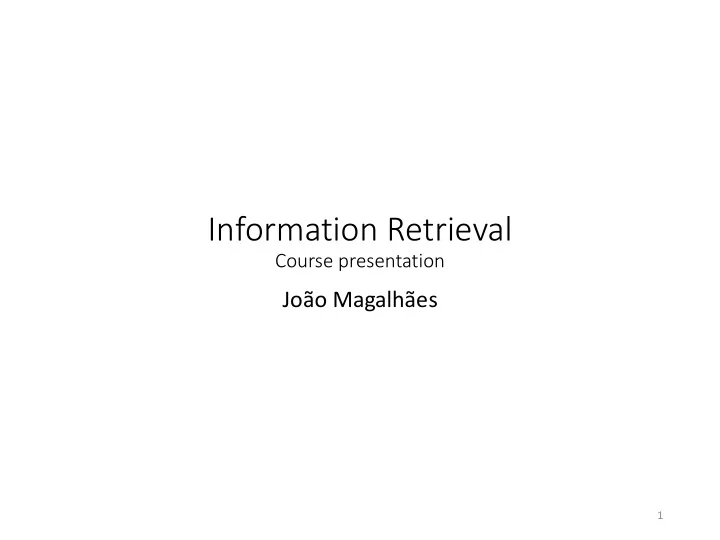

Information Retrieval Course presentation João Magalhães 1
Relevance vs similarity Multimedia Query Information documents retrieval application Documents Information User side side What is the best [search space + dissimilarity function] to compute the relevance of documents for a given user information need? 2
What makes a good search application? • Efficiency : application replies to user queries without noticeable delays. • 1 sec is the “limit for users feeling that they are freely navigating the command space without having to unduly wait for the computer” • Miller, R. B. (1968). Response time in man-computer conversational transactions. Proc. AFIPS Fall Joint Computer Conference Vol. 33, 267-277. • Effectiveness : application replies to user queries with relevant answers. • This depends on the interpretation of the user query and the stored information. 3
The tasks of a search application • Collect data for storage • Crawler • Analyse collected data and compute the relevant information • Information analysis • Store data in an efficient manner • Indexing • Process user information needs • Querying • Find the documents that best match the user information need • Ranking 4
Web crawling Web URLs crawled and parsed Unseen Web Seed pages URLs frontier Begin with known “seed” URLs Fetch and parse them Extract URLs they point to Place the extracted URLs on a queue Fetch “robots.txt” Fetch each URL on the queue and repeat 5
Information analysis • This stage deals with the extraction of the information to be made searchable • Extract meaningful words, pairs of words or n-grams • Extract images and their main characteristics • Link visual characteristics and text data 6
Indexing • This stage creates an index to quickly locate relevant documents • An index is an agregation of several data structures (e.g. several B-trees) • Index compression is used to reduce the amount of space and the time needed to compute similarities • The distribution of the index pages across a cluster improves the search engine responsiveness 7
Querying • Conversion of the user query into the internal search space • Parsing • Usage history • Cookies, profiles, etc. • User intention • What type of task is the user doing? 8
Ranking • Once the user query is converted into the internal search space... • The ranking function sorts the information according to its relevance to the user query • Ranking functions should model the human notion of relevance • We don’t really know the mathematical form of the human notion of similarity... 9
Putting all together... Indexes Query Indexing Ranking Application Results Documents User Information Query Query analysis processing Multimedia documents Crawler 10
References • Slides and articles provided during classes. • Books: • C. D. Manning, P. Raghavan and H. Schütze , “Introduction to Information Retrieval”, Cambridge University Press, 2008. • Stefan Buettcher, Charles L. A. Clarke, Gordon V. Cormack, “ Information Retrieval: Implementing and Evaluating Search Engines”, The MIT Press, 2010. 11
Course grading • The course has two mandatory components: • Theoretical part (1 test or 1 exam): 40% (minimum grade > 9.0) • Labs (groups of 3 students): 60% (minimum grade > 9.0) • Theory test/exam: • Test: 12 December • Exam: date to be defined • Additional rules: • You may use one sided A4 sheet handwritten by you with your notes. • It must be handed at the end of the test. • Individual mini-lab grading (minimum grade > 8.0) • 30% implementation + 20 % report + 20% questions + 30% discussion 12
Laboratories: News search • Implement a search engine to search online news. • Understand the roles of each component of a search engine in the performance of the search results. • Labs are done incrementally. Each week new functionalities will be added to the initial implementation. • There will be 4 mini-labs throughout the semester. • The submission date of each mini-lab is three days after the last lab class of the corresponding mini-lab. 13
Schedule Information Retrieval Week Week # Lectures In-class labs 12-Sep-18 1 Introduction 19-Sep-18 2 Basic techniques (Lucene examples) Environment setup Lab 1 26-Sep-18 3 Evaluation Text pre-processing, VSM 03-Oct-18 4 Retrieval models: LM + BIM + BM25 Evaluation scripts 10-Oct-18 5 Implementation of Ret Models Retrieval models Lab 2 6 Query processing and taxonomies Retrieval models 17-Oct-18 24-Oct-18 Reports discussion Query expansion Lab 3 31-Oct-18 7 Information duplicates Query expansion 07-Nov-18 8 Multiple fields and rank fusion Query expansion 14-Nov-18 9 - Ranking multiple fields 21-Nov-18 10 Static and distributed indexing Ranking multiple fields Lab 4 28-Nov-18 11 Efficient query processing Ranking multiple fields 05-Dec-18 12 Elasticsearch vs Lucene Ranking multiple fields 12-Dec-18 Test + Reports discussion 14
Summary • “Information Retrieval” course context • Course objectives and plan • Grading • Labs 15
Recommend
More recommend